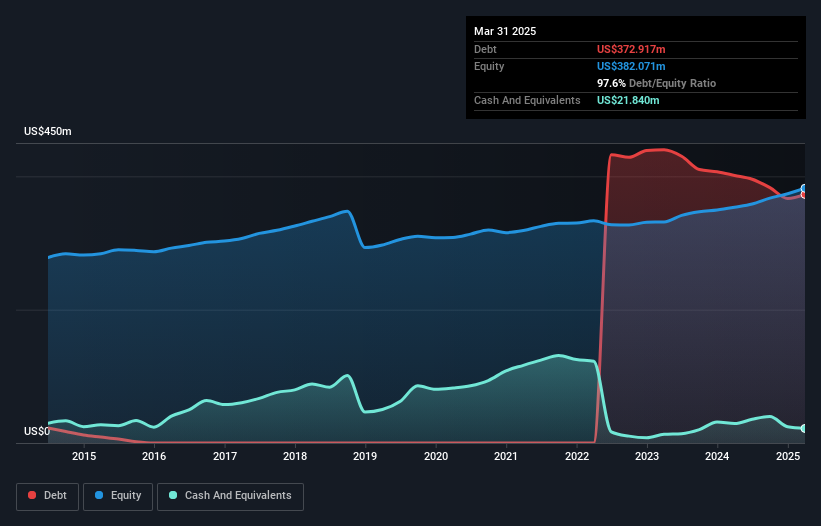Legendary fund manager Li Lu (who Charlie Munger backed) once said, 'The biggest investment risk is not the volatility of prices, but whether you will suffer a permanent loss of capital.' So it seems the smart money knows that debt - which is usually involved in bankruptcies - is a very important factor, when you assess how risky a company is. We can see that The Gorman-Rupp Company (NYSE:GRC) does use debt in its business. But the more important question is: how much risk is that debt creating?
We've discovered 1 warning sign about Gorman-Rupp. View them for free.When Is Debt A Problem?
Debt is a tool to help businesses grow, but if a business is incapable of paying off its lenders, then it exists at their mercy. Part and parcel of capitalism is the process of 'creative destruction' where failed businesses are mercilessly liquidated by their bankers. However, a more usual (but still expensive) situation is where a company must dilute shareholders at a cheap share price simply to get debt under control. Of course, debt can be an important tool in businesses, particularly capital heavy businesses. When we think about a company's use of debt, we first look at cash and debt together.
How Much Debt Does Gorman-Rupp Carry?
As you can see below, Gorman-Rupp had US$372.9m of debt at March 2025, down from US$401.4m a year prior. However, because it has a cash reserve of US$21.8m, its net debt is less, at about US$351.1m.

How Strong Is Gorman-Rupp's Balance Sheet?
Zooming in on the latest balance sheet data, we can see that Gorman-Rupp had liabilities of US$92.7m due within 12 months and liabilities of US$383.1m due beyond that. Offsetting this, it had US$21.8m in cash and US$93.5m in receivables that were due within 12 months. So it has liabilities totalling US$360.4m more than its cash and near-term receivables, combined.
While this might seem like a lot, it is not so bad since Gorman-Rupp has a market capitalization of US$924.5m, and so it could probably strengthen its balance sheet by raising capital if it needed to. But we definitely want to keep our eyes open to indications that its debt is bringing too much risk.
See our latest analysis for Gorman-Rupp
In order to size up a company's debt relative to its earnings, we calculate its net debt divided by its earnings before interest, tax, depreciation, and amortization (EBITDA) and its earnings before interest and tax (EBIT) divided by its interest expense (its interest cover). Thus we consider debt relative to earnings both with and without depreciation and amortization expenses.
Gorman-Rupp's debt is 2.9 times its EBITDA, and its EBIT cover its interest expense 3.1 times over. Taken together this implies that, while we wouldn't want to see debt levels rise, we think it can handle its current leverage. Fortunately, Gorman-Rupp grew its EBIT by 5.4% in the last year, slowly shrinking its debt relative to earnings. The balance sheet is clearly the area to focus on when you are analysing debt. But it is future earnings, more than anything, that will determine Gorman-Rupp's ability to maintain a healthy balance sheet going forward. So if you want to see what the professionals think, you might find this free report on analyst profit forecasts to be interesting.
Finally, a business needs free cash flow to pay off debt; accounting profits just don't cut it. So the logical step is to look at the proportion of that EBIT that is matched by actual free cash flow. Over the most recent three years, Gorman-Rupp recorded free cash flow worth 61% of its EBIT, which is around normal, given free cash flow excludes interest and tax. This cold hard cash means it can reduce its debt when it wants to.
Our View
Based on what we've seen Gorman-Rupp is not finding it easy, given its interest cover, but the other factors we considered give us cause to be optimistic. In particular, we thought its conversion of EBIT to free cash flow was a positive. When we consider all the factors mentioned above, we do feel a bit cautious about Gorman-Rupp's use of debt. While we appreciate debt can enhance returns on equity, we'd suggest that shareholders keep close watch on its debt levels, lest they increase. There's no doubt that we learn most about debt from the balance sheet. But ultimately, every company can contain risks that exist outside of the balance sheet. We've identified 1 warning sign with Gorman-Rupp , and understanding them should be part of your investment process.
When all is said and done, sometimes its easier to focus on companies that don't even need debt. Readers can access a list of growth stocks with zero net debt 100% free, right now.
New: Manage All Your Stock Portfolios in One Place
We've created the ultimate portfolio companion for stock investors, and it's free.
• Connect an unlimited number of Portfolios and see your total in one currency
• Be alerted to new Warning Signs or Risks via email or mobile
• Track the Fair Value of your stocks
Have feedback on this article? Concerned about the content? Get in touch with us directly. Alternatively, email editorial-team (at) simplywallst.com.
This article by Simply Wall St is general in nature. We provide commentary based on historical data and analyst forecasts only using an unbiased methodology and our articles are not intended to be financial advice. It does not constitute a recommendation to buy or sell any stock, and does not take account of your objectives, or your financial situation. We aim to bring you long-term focused analysis driven by fundamental data. Note that our analysis may not factor in the latest price-sensitive company announcements or qualitative material. Simply Wall St has no position in any stocks mentioned.
About NYSE:GRC
Gorman-Rupp
Designs, manufactures, and sells pumps and pump systems in the United States and internationally.
Solid track record established dividend payer.
Similar Companies
Market Insights
Community Narratives




